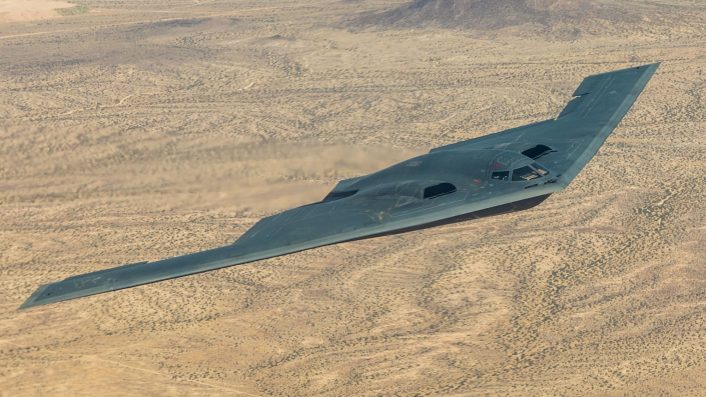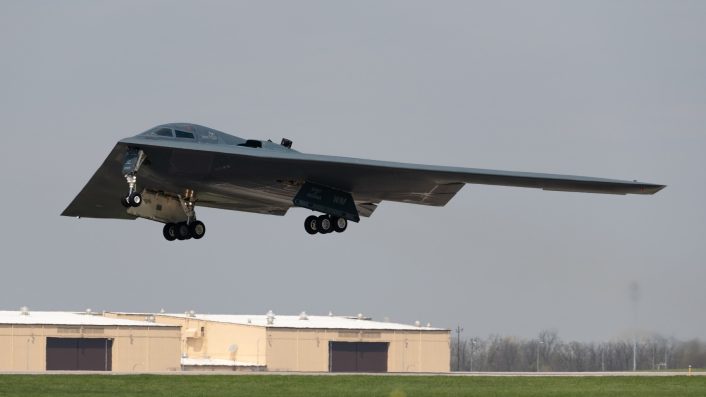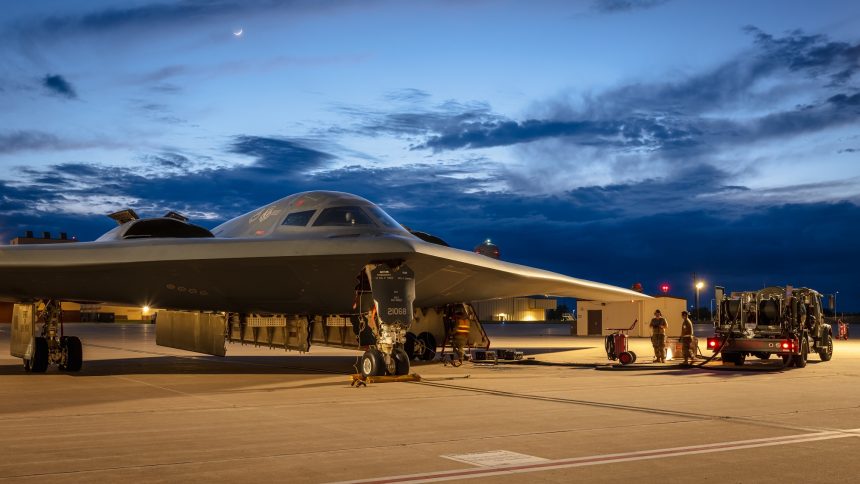Novel capabilities ensure B-2 crews can ‘aviate, navigate, communicate, strike their targets, and get home safely’ with a bomber which ‘remains ready, effective, and survivable.’
The U.S. Air Force Life-Cycle Management Center (AFLCMC) has revealed a series of continuing software upgrades to the B-2 Spirit stealth bomber, particularly pertaining to its communications and survivability. These are planned to “happen continuously to ensure the B-2 fleet remains operational until the B-21 is fielded.”
The upgrades are conducted by the B-2 Advanced Programs Branch, as “rapidly and frequently providing modernization capabilities keeps the B-2 ahead of emerging threats.” The work takes place at the AFLCMC’s Bombers Directorate’s in-house laboratory at Tinker AFB in Oklahoma.
The upgrades “may include acquisition programs that modify either hardware or software,” explained the press release. The insight into the line of upgrade comes after seven B-2s struck Iran’s nuclear facilities with GBU-57 MOP (Massive Ordnance Penetrator) bombs on Jun. 21, 2025, in a carefully orchestrated operation, called ‘Operation Midnight Hammer’, that was 15 years in the making.
The B-2 Spirit, the mainstay of the Air Force’s long-range conventional and non-conventional airborne strategic strike roles, will be upgraded to remain “competitive” at least until the early-2030s, when it is planned to be replaced by the new B-21 Raider. The service operates 19 B-2s, putting them through a rigorous and exhaustive Programmed Depot Maintenance (PDM) every nine years at Northrop Grumman’s Plant 42 in Palmdale, California.
The B-2 Spirit stealth bomber is a game changer. It’s capable of penetrating heavily defended airspaces, delivering both conventional and nuclear munitions worldwide. The Spirit is a testament to our commitment to national security and global stability. pic.twitter.com/P0GWDOxPtA
— Department of Defense 🇺🇸 (@DeptofDefense) June 4, 2025
Communications and survivability upgrades
New required capabilities are identified by the B-2 Advanced Programs Branch by studying emerging threats, and are then undertaken by two Integrated Program Teams (IPT) teams, representing the two lines of efforts for the B-2: Advanced Communications and Survivability. The program is overseen by the B-2 Systems Programs Office (SPO) within the AFLCMC’s Bomber’s Directorate, which “ensures this strategic platform remains ready, effective, and survivable.”
The Advanced Communications team works on providing new communication capabilities, the latest being an upgraded beyond-line-of-sight satellite communications suite. Lt. Col. Robert Allen, Materiel Leader for the B-2 Advanced Programs Branch, said in the release this “significantly improves the transfer time for real time mission planning data,” allowing to “simultaneously receive and transmit voice communications and data which is an upgrade from what the aircraft currently has.”
The Survivability IPT focuses on improving the B-2’s “low observable materials to enhance its radar cross section signature,” and “improving the B-2’s situational awareness in a highly contested environment.” This provides the crew with “the latest battlefield picture, giving them the ability to adapt and be even more effective and ready for the fight,” explains the press release.
“We are ensuring the aircraft’s systems sensors are functioning optimally to engage our targets effectively and accurately,” said Col. Francis Marino, B-2 System program manager. “We are maintaining readiness by reducing downtime and increasing aircraft availability.”
Technicians strip paint from a B-2 bomber using high pressure air and wheat starch. The whites structures create an air wall that force the residues into the floor vents . AWST 1996 #aviation pic.twitter.com/R4J3OiqkgI
— The Shadow of the Eagle (@clemente3000) November 3, 2021
From the description, we can assume the upgrade includes more secure, encrypted radios, with software defined transmission and an updated threat library of hostile radar and electromagnetic frequencies, based on the latest intelligence. These “novel capabilities ensure our operators can aviate, navigate, communicate, strike their targets, and get home safely,” Allen added.
Other B-2 upgrades
There are also parallel upgrade efforts for the B-2 Spirit fleet, the primary one of them being the Spirit Realm 1 (SR1). This involves the integration of an open mission systems architecture, new software, sensors and weapons, to enhance the B-2’s survivability and combat capability.
According to The War Zone, the phased software releases could also extend to the B-2’s sensors, but it is not known what they exactly constitute and how many bombers have been put through the program so far. It is also therefore unclear if the SR1 and the latest software and hardware mentioned by AFLCMC are related or a separate effort, and if these too have to be undertaken at Plant 42.
Amanda Seiler, the B-2 Integrated Function Capabilities Branch deputy program manager said they have “anywhere from two-to-three upgrades in the queue, going on at any given time in various phases of coding, development, testing and fielding,” referring to the work at the in-house laboratory. “One of our programs contains over 300-plus software changes to its sustainment software,” Seiler adds.
Meanwhile, the PDMs involve the B-2s being put through an exhaustive inspection of all electrical and mechanical systems along with a complete removal and reapplication of their radar-evading materials to restore the LO (Low Observable) features.

B-2 continuing relevance
The AFLCMC center touched upon the iconic B-2’s history and its continuing relevance for the USAF’s future missions, even if it was first designed in the late 1970s and early 1980s. “Designed during the height of the Cold War, its purpose was to penetrate heavily defended enemy airspace, operating independently to destroy critical strategic targets,” the AFLCMC statement said.
The bomber reached Initial Operational Capability on Jan. 1, 1997, and had its combat debut in the Kosovo War, supporting Operation Allied Force.
The AFLCMC revealed how the B-2, despite accounting for less than one percent of the Department of Defense’s budget and conducting less than 10 percent of combat sorties, still “dropped 62 percent” of the total munitions used. It is not known what period this figure corresponds to, and if it takes into account the recent strikes on Iran’s nuclear facilities.

The press release about the upgrade efforts – an unusual topic for a press release by the U.S. Air Force standards – come within days of such a major operation. Allen also dispelled the notion about the B-2 being a mere “legacy platform” as “incorrect,” explaining that the B-2 “is an operational platform conducting strikes today and if the flag goes up tomorrow, it will be one of the first platforms to conduct strikes.”
The B-2 Spirit’s “continued modernization and sustainment” is “crucial for maintaining United States military air superiority,” with its ”only long-range penetrable strike bomber serving both nuclear and conventional missions is always ready and remains a viable platform for decades to come.”
.@USAirForce B-2 Spirit bombers recently returned safely to Whiteman AFB, Mo., after a successful 36-hour mission to the @CENTCOM area of responsibility.#USSTRATCOM warfighters are committed to delivering #PeaceThroughStrength #AnytimeAnywhere.@DeptOfDefense | @AFGlobalStrike pic.twitter.com/6idyhmR2sw
— United States Strategic Command (@US_STRATCOM) June 23, 2025
“The B-2 is a strategic asset that provides the U.S. military with unique capability to penetrate heavily defended airspace and deliver precision guided munitions,” said Lt. Col. Benjamin Elton, material leader, B-2 Integrated Capabilities Branch. “Upgrading its avionics, sensors and communication systems are essential so that we stay ahead of emerging threats and enhance our payload and versatility.”









